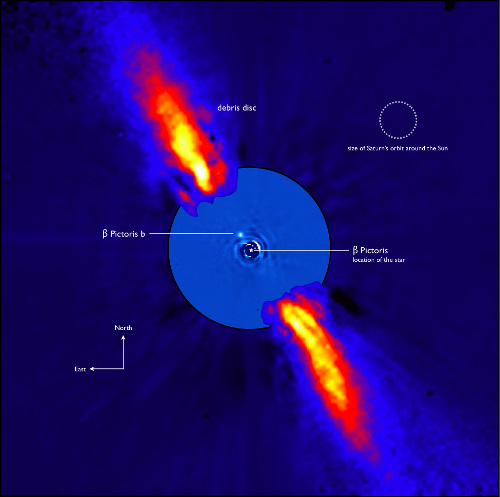New findings from the Herschel space observatory demonstrate how effective the infrared telescope can be at teasing out details of distant planetary systems. At issue is the system around Beta Pictoris, a young star (12 million years old) some 63 light years from the Earth. We’re looking at planetary system formation in progress here, with a single gas giant planet and a dusty debris disk that may be the forerunner of a disk much like our own Edgeworth/Kuiper Belt, the collection of icy bodies that orbits outside the orbit of Neptune.
Ben de Vries (KU Leuven) is lead author of the paper on the new Herschel data, which examines the composition of dust in the outer regions of the Beta Pictoris disk. The study, reported today in Nature, presents a photometric and spectral analysis of dust particles produced when planetesimals in this region collide. The key player here is olivine, a mineral associated with protoplanetary disk material around newborn stars. The olivine found around Beta Pictoris is similar to that found in the dust of primitive Solar System comets.
Herschel has been detecting a magnesium-rich variety of olivine at a distance of 15-45 AU from the star. While olivine can crystallize out of protoplanetary disk material, it eventually becomes part of larger bodies, from comets to asteroids and planets. Usefully, the two states of olivine can be distinguished from each other, as de Vries explains in this ESA news release:
“As far as olivine is concerned, it comes in different flavours. A magnesium-rich variety is found in small and primitive icy bodies like comets, whereas iron-rich olivine is typically found in large asteroids that have undergone more heating, or ‘processing’.”
Moreover, finding olivine in the cold debris disk is itself a marker, for the mineral can only crystallize within about 10 AU of the star. The de Vries team assumes that radial mixing processes are at work, produced not only by stellar winds and heat from the central star but by temperature differences and turbulence in the protoplanetary disk itself. The Herschel data show that olivine crystals make up 3.6?±?1.0 percent of the total mass of the dust found in this outer region, a figure similar to the Solar System comets 17P/Holmes and 73P/Schwassmann-Wachmann 3, according to de Vries.

Image: Infrared view of the Beta Pictoris solar system, obtained by combining data from the ADONIS instrument on ESO’s 3.6 m telescope (outer regions) and the NACO instrument on one of the 8.2 m units of ESO’s Very Large Telescope (inner region), and then subtracting the overpowering glare of the central star. The image shows a planet orbiting at roughly the same distance from Beta Pictoris as Saturn is from our own Sun, and a prominent dust disc in the outer reaches of the system. New observations from ESA’s Herschel space telescope have found magnesium-rich olivine crystals in the disc that likely originated from collisions between comets: the dust shares the same compositional characteristics as in several comets in our Solar System. Furthermore, the observation of these olivines in the outer dust disc suggest that they have been transported from their birthplace close to the central star, since they cannot form under the cold conditions found further out. Credits: ESO/A-M. Lagrange et al.
The findings are helpful because they point to basic processes of planetary system growth. Beta Pictoris is one and a half times as massive as the Sun and eight times as bright, but the radial mixing process at work here looks to be roughly the same as that postulated for the early Solar System. Measuring residual materials from an early exoplanetary system is an impressive feat and a reminder of Herschel’s capabilities. Launched in 2009, this is the first observatory to span the entire range from far-infrared to submillimeter wavelengths, pushing deeper into the far infrared than any previous mission. Meanwhile, Beta Pictoris continues to be an ideal ‘laboratory’ for watching a young system grow. It doubtless has much more to teach us.
The paper is de Vries et al., “Comet-like mineralogy of olivine crystals in an extrasolar proto-Kuiper belt,” Nature 490 (04 October 2012), pp. 74-76 (abstract).



Fomalhaut is supposed to have a huge debris belt, many times the mass of our asteroid and Kuiper belts.
BTW, our own Kuiper belt has a “cutoff” at about 48 AU’s out. Perhaps there is a third belt of material further out, say several hundred AU’s out.
Are you referring to the Oort Cloud, which may extend halfway to Alpha Centauri:
http://www.space.com/16401-oort-cloud-the-outer-solar-system-s-icy-shell.html
Which makes one wonder if the Alpha Centauri system has a similar distant region of comets which might mingle with ours?
Beta Pictoris is a really intriguing system. Certainly of the IRAS “Fabulous Four” (the others being Vega, Fomalhaut and Epsilon Eridani) it has produced the most impressive results.
http://arxiv.org/abs/1212.0809
The Comets of Caroline Herschel (1750-1848), Sleuth of the Skies at Slough
Authors: Roberta J. M. Olson, Jay M. Pasachoff
(Submitted on 4 Dec 2012)
Abstract: In this paper, we discuss the work on comets of Caroline Herschel, the first female comet-hunter. After leaving Bath for the environs of Windsor Castle and eventually Slough, she discovered at least eight comets, five of which were reported in the Philosophical Transactions of the Royal Society.
We consider her public image, astronomers’ perceptions of her contributions, and the style of her astronomical drawings that changed with the technological developments in astronomical illustration.
Comments: 26 pages, 19 figures, from the Seventh Conference on the Inspiration of Astronomical Phenomena, INSAP7, held in Bath in 2010 (insap.org)
Subjects: History and Philosophy of Physics (physics.hist-ph); Earth and Planetary Astrophysics (astro-ph.EP); Popular Physics (physics.pop-ph)
Cite as: arXiv:1212.0809 [physics.hist-ph]
(or arXiv:1212.0809v1 [physics.hist-ph] for this version)
Submission history
From: Jay Pasachoff [view email]
[v1] Tue, 4 Dec 2012 18:06:39 GMT (7086kb)
http://arxiv.org/ftp/arxiv/papers/1212/1212.0809.pdf